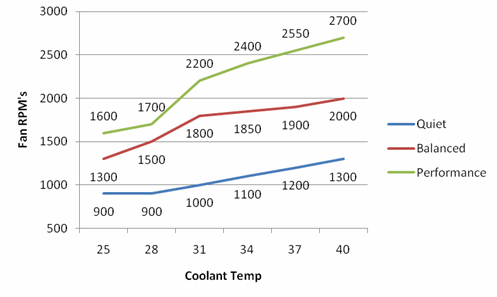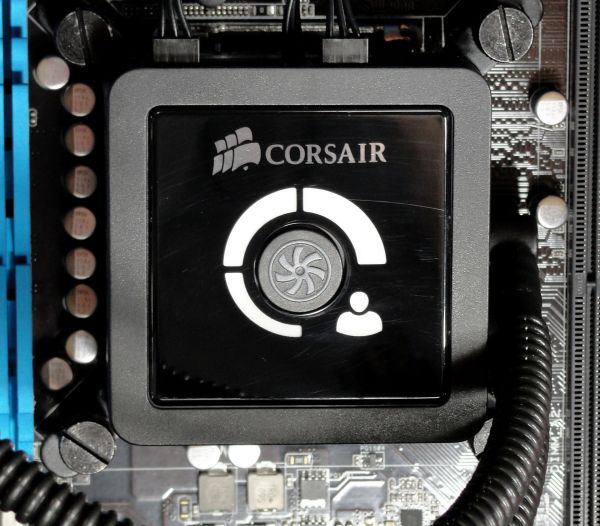Corsair Hydro Series: H60, H80 and H100 Reviewed
by Jared Bell on November 7, 2011 12:00 AM EST- Posted in
- Cases/Cooling/PSUs
- Corsair
- Water Cooling
H60, H80, and H100 Overview
As always with Corsair products, packaging and box art are top notch. We’ll start with the lowest tier offering, the H60, and then move to the H80 and H100.
H60 High Performance Details
The H60's radiator is the same size of the previous generation H50. However, the H60 has a new, upgraded water block that allows for more efficient flow. It also has the adjustable 90 degree connectors we've seen on the H70 making installation easier. Corsair provides a single 120mm 1700RPM PWM fan. The inclusion of a PWM fan is a nice touch since most motherboards have the needed 4-pin connector and have BIOS settings for easy fan speed control. This means the cooler can be virtually silent when idle, but ramp up the RPMs (and therefore noise) as needed. As mentioned, the H60 only includes one fan, but you can add a second fan for a push/pull configuration. You'll just need to pick up an extra set of 6x32x1-1/4" screws.
H80 High Performance
The H80 takes over for the H70 with its thicker radiator design but shares the same new, upgraded water block as the H60. However, the H80 and the H100 have an all new push-button fan control that lets you select the fan speed and cooling performance setup that best suits your needs. The white LED display lets you know which profile is being used. The H80 can power and control up to two fans. Thankfully, like the H70 before it, the H80 already comes with two fans for a push/pull configuration. The included fans are 3-pin and spin at 2500RPM when the fan controller is set to its highest setting. We’ll provide more information on the fan speed profiles later.
H100 Extreme Performance
The H100 is an all new double-wide design sporting a 240mm [or 2x120mm] radiator that has the same thickness as the H60. The water block and fan controller are the same that we've seen on the H80; however, the H100's fan controller can power and control up to four fans even though the unit only comes with two. This gives you the option of adding two more fans for push/pull on this bad boy. The two included fans are the same high speed 2500RPM fans that come with the H80.
Fan Controller
The three speed push-button fan controller on the H80 and H100 is a great improvement over what Corsair offered previously with the H70. The H70 included two inline resistors for providing a second, lower fan speed. The new built-in fan control system on the H80 and H100 gives you three settings to choose from: low, medium, or high—or as Corsair calls it: low noise, balanced, and high performance. While some may complain you have to open your case to make changes, I think of it as more of a set it and forget it type thing. Corsair doesn't stop there though; each speed setting or profile actually has an RPM range for the fans to spin at. This means the fans will be quieter when idle and only reach their max rated RPM (and max noise) for that particular profile when the coolant inside reaches a certain temperature. Could this lead to the perfect balance of performance and noise? We'll hopefully find out with our tests in just a moment.

Corsair Link
The H80 and H100 both support Corsair's Link Digital, which is their suite of hardware and software for monitoring various system parameters. It also allows you to customize your own performance profiles. We don't have one of the Corsair Link's on hand, so we will not be testing this feature. It's unfortunate that Corsair doesn't include the Link with the H80 or H100, but I'm guessing they opted to make it optional so the price wouldn't go through the roof.



























91 Comments
View All Comments
Mjello - Monday, November 7, 2011 - link
Mine is the old version with the bulky cooler/pump unit. May even be other make. I dont remember and don't care to open the computer to check. However its a dual 120mm fan radiator in a closed loop ready to use. Just as this one. And I don't think there is much diff. if any at all ;). I actually thought mine was the h100.Gonemad - Monday, November 7, 2011 - link
I am a bit concerned about systems that consider the placement of the Fan on top of the CPU to cool everything else around it, like the ram, and so forth. This radiator installation inside the case seems to help this unease feeling.Mjello - Monday, November 7, 2011 - link
I found that the power supply fan alone is creating sufficient airflow in the kabinet for cooling the motherboard components when there is no cpu fan. But I dont overclock in the extreme. And motherboards are not all the same.Oberst - Monday, November 7, 2011 - link
Hello,could you please also post the dimensions of the cooling unit (cooler, pump unit, fan controller)?
That would be quite interesting for people mounting the radiator externally and putting the cooling unit through a fan hole ore something similar into the case onto the mainboard.
As the price difference in Europe between the H80 and H100 is quite low (only about 9 Euros), i'm interested in upgrading my quite old case with a external mounted H100.
k.r. Oberst.
haplo602 - Monday, November 7, 2011 - link
I have a dual CPU system with 92mm coolers (no space for larger ones). However the case has holes on top for 2x140mm fans. Would to H60 radiators fit there next to each other ?I know I can do a better and cheaper open loop with one radiator and the CPU waterblocks in series, but I like the idea of cooling both CPUs as they needed and not as the more loaded one needs.
geniekid - Monday, November 7, 2011 - link
This is definitely a niche product, even for enthusiasts. One of the biggest selling points of water cooling is to reduce fan noise, but it looks like the fans on these things aren't much quieter than the stock fan for low load usage (i.e. normal HTPC use). For gaming machines, the biggest noise offenders (in my anecdotal, personal experience) are usually the GPU and the power supply fans.Maybe if your goal is to overclock as much as possible with a cooling solution around $100, then this is for you, but I would have to see many more comparisons to air coolers and alternative water coolers before I'd be convinced of that.
kg4icg - Monday, November 7, 2011 - link
Have no problems what so ever mounting the H100 inside a Corsair Carbide 400R case. 500 and 600 Carbides are the same way.[IMG]http://i445.photobucket.com/albums/qq175/kg4icg/te...[/IMG]
WT - Monday, November 7, 2011 - link
I bought an H80 for my new build to cut down on the noise that my current air cooler (Nirvana NV120) created, and to that end it is an amazing difference, so I consider it a worthwhile purchase for what I wanted.As far as the directions, I agree that they are pitiful, and I even had to do a google search (Corsair tech support hours = Mon-Fri) to find out where the 4 included washers were to be mounted.
I did end up replacing the 2 stock Corsair fans with Gentle Typhoon AP-15's, and I mounted them so that they blow out of the case rather than pulling air from outside as Corsair recommends.
Beenthere - Monday, November 7, 2011 - link
There are plenty of quiet HSFs that perform as well or better than the Corsair CLCs and cost less. Having to spend more moeny for quiet fans makes a Corsair CLC an even worse value. The biggest liability with H2O cooling however is the damaged from leaks that can destroy hundreds of dollars in PC hardware and for what when there is no advantage to a Corsair CLC.Buy what makes you happy but don't buy the Corsair or other brands of CLCs for thermal efficiency, quietness, value or reliability because they suffer in these areas compared to a decent HSF.
pcfxer - Monday, November 7, 2011 - link
And yet liquid cooling is still FAR too loud for any SPCR reader, that's for sure!